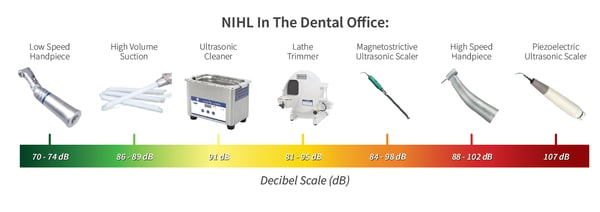Dentistry’s Deafening Silence™
It wasn’t long after starting to practice that I recognized the irritation and additional stress I experienced from the shrill of the handpiece and the shrieks from the suction; it can truly drive you crazy! I also noticed that many of my colleagues complained of tinnitus (ringing in ears) and hearing difficulties, and I knew there was a serious problem that was not being recognized.
Dental professionals today have more personal protective equipment and regulations in the office space than ever before, yet one issue has continued to remain silent; hearing loss. Noise-induced hearing loss (NIHL) is permanent, irreversible and nearly a guarantee to some degree for all dental professionals. Hearing loss ranks as the second most work related illness/injury, and in the United States, hearing issues have affected over 25% of the population (1).
We as dental professionals are exposed to constant dangerous levels of noise that have a long-term permanent effect on our hearing. Most usually identified with the high speed handpiece, yet high speed suctions, ultrasonic instruments and cleaners along with lab equipment and model trimmers all cause damage.
Sounds that measure 85 decibels (db) and above result in hearing damage and are directly related to the duration and frequency of exposure, among other factors (2). Thus extreme noise exposure for short periods of time can damage equally as mild exposure for prolonged periods. Considering that as dental professionals our average careers are 35 years long and typically 40 hours/week, our exposure time spent in this chronic noise environment is substantial. Studies show values for dental equipment that clearly exceed 85db and in many cases over 100db (3). Noise standards further illustrate that at these ranges as little as 15min-2 hours of exposure daily can lead to permanent damage (4).

Hearing loss, specifically noise-induced hearing loss (NIHL) which plagues our industry, is 100% preventable. We have the option to protect one of our five senses from permanent and irreversible damage, yet we are doing nothing.
The American Dental Association published (5, 6) as early as 1974 with the recommendation of using hearing protection in the dental operatory, and since that time endless publications have pointed out the risks and also recommended hearing protection (1, 7). So why have we ignored the warnings? For one, our options in the past were very limited.
Traditional foam ear plugs result in significant muffling of sounds and the inability to communicate with patients and staff; studies show this as the number one reason hearing protection has been avoided (8). Even newer, high tech solutions like noise-canceling headphones are not practical for our environment as they are big, bulky, and again, eliminate our ability to communicate.
What we need is something small and lightweight that can both protect us from the damaging high decibel and frequency sound levels we are exposed to, while simultaneously not affecting our ability to hear clearly and communicate with patients and staff. This technology simply never existed until recently and is known as active hearing protection. Using a tiny electronic microchip, the high level damaging sounds are instantly isolated and compressed to lower levels while still maintaining an “open ear” response, resulting in 100% HD hearing. Our communication remains clear and unaffected, while hearing damage is prevented. With this new technology, we truly have a solution that will address all our concerns and solve our noise exposure issues.
Utilizing the best form of this electronic technology, and fitting the necessary decibel level protection cited in the literature, EarAID™ is the ideal solution to our hearing issues in the dental environment. It’s lightweight, simple to use, and the effects are immediate. With EarAID, our communication remains clear and unaffected, while hearing damage is prevented. We finally have the right solution that will address all our concerns and solve our noise exposure issues.
It’s time we as individual practitioners take a stand and begin seriously addressing Dentistry’s deafening silence. Ultimately, it’s not a question of if, but rather when and to what extent our hearing and quality of life will be affected by our profession. So, the next time you hear your high-speed handpiece, suction and/or ultrasonics, ask yourself if you want that to be the reason you do not hear your grandchildren say “I love you” one day.
For information about EarAID, please visit the Forward Science booth #301 at the AAOSH Scientific Session in Nashville or https://forwardscience.com/earaid.
References
- Themann CL, Suter AH, Stephenson MR. National research agenda for the prevention of occupational hearing loss—part 1. Semin Hear 2013;34:145–207 Deloitte Access Economics, Social and Economic Costs of Hearing Loss in NZ, 3 Dec 2016
- National Institute on Deafness and Other Communication Disorders- United States Department of Health
- Folmer- Hearing Loss Associated with Long-term Exposure to High Speed Dental Handpieces- General Dentistry May 2015
- OSHA and NIOSH Noise Standards- Centers for Disease Control and Prevention
- Noise Control in the Dental Operatory- Journal of the American Dental Association; Council on Dental Materials and Devices- December 1974
- Noise Control in the dental operatory. Council on Dental Materials and Devices. J Am Dent Assoc 1974;89(6):1384-1385.
- Cooperman HN. Deafness to the dentist caused by high speed handpieces. Pak Dent Rev 1965:15(3);108- 110
- Reddy RK,Welch- Dental Hearing Protection use in manufacturing workers: A Qualitative Study- NoiseHealth 2012;14(59):202-209
